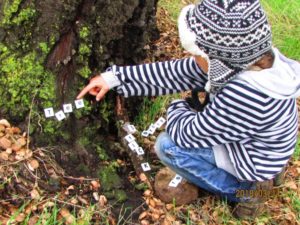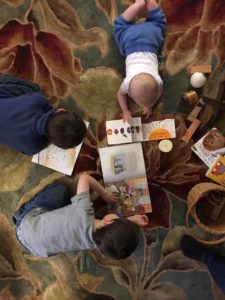
In the early grades (K-2), Oak Meadow’s primary focus in language arts is building a strong foundation of skills needed for reading and writing. Our approach is gentle and no-pressure; we believe children begin to read and write when they are ready.
The development of literacy is a complex task that involves two primary skills: decoding (forming a sound according to the printed symbol, i.e., reading) and encoding (creating the symbol that corresponds to the sound, i.e., writing).
Our Hybrid Approach
There are several ways to learn these primary skills. Oak Meadow’s hybrid approach to teaching reading and writing combines phonics and whole language methods.
Phonics Method
Phonics involves matching sounds to letters and learning spelling rules to decode words. This is considered a “bottom-up” approach, where students look at the individual elements of each word (letters) rather than the word as a whole. This allows students to read any unfamiliar words by sounding them out.
Whole Language Method
 The whole language approach looks at words as whole elements instead of piece by piece (letter by letter). This involves memorizing sight words and gaining reading comprehension through context (how words relate to one another). This is considered a “top-down” approach that encourages literacy through speaking and listening as well as reading and writing. Students are introduced to a rich language environment rather than limited to simple texts with words they can easily decode.
The whole language approach looks at words as whole elements instead of piece by piece (letter by letter). This involves memorizing sight words and gaining reading comprehension through context (how words relate to one another). This is considered a “top-down” approach that encourages literacy through speaking and listening as well as reading and writing. Students are introduced to a rich language environment rather than limited to simple texts with words they can easily decode.
Using the hybrid approach, Oak Meadow encourages students to gain exposure to complex language structures and vocabulary through listening to books and stories above their reading level. They learn to write by copying sentences summarizing story content and then reading aloud what they have written. At the same time, students learn letter sounds and combinations, experiment with word family groupings, and play with letter sounds and shapes through physical activities, rhyming games, and other word play. Phonics support whole language learning and vice versa.
Here are a few examples of how our language arts curriculum works in grades K-2:
Teaching Letters
In Kindergarten, capital letters are introduced individually through stories and illustrations. Capital letters are easier to write than lowercase letters, so they make an excellent starting point. Students are not expected to read by the end of kindergarten, but rather are encouraged to engage with reading at their level by listening to their home teacher read aloud, following along, or reading aloud themselves.
First grade begins with a review of capital letters and an introduction to lowercase letters. Letter recognition and awareness of vowel and consonant sounds are introduced through stories and images in a very creative, imaginative way. The parent is encouraged to integrate this story/letter work with daily life so the child is able to absorb this new knowledge in an organic, relaxed way.
Acquiring Reading Skills
 In the course of learning to write, the child naturally begins to learn to read by reading what they have written. In kindergarten and first grade, children create a Main Lesson Book, which is a large blank book that eventually becomes filled with letters, drawings, sentences, stories, poems, etc.
In the course of learning to write, the child naturally begins to learn to read by reading what they have written. In kindergarten and first grade, children create a Main Lesson Book, which is a large blank book that eventually becomes filled with letters, drawings, sentences, stories, poems, etc.
Later in the first grade year, students who are ready begin using a reader, expanding on the work they have done with word families (-it, -at, -ag, etc.). “Readers” are books that a child reads independently, with or without the support of the home teacher. These books are often used as read-aloud books by the parents of children who are not yet reading independently, or used as read-together books to solidify skills and instill confidence in emerging readers. Beginning readers are included with 1st and 2nd grade curriculum packages.
Adding Challenge
For students who are eager for more challenges, it is relatively simple to add depth and complexity to the assignments without having to stray very far from the lesson framework. For example, if the assignment is to memorize a four-line verse emphasizing the long “a” sound, you might have your child write and illustrate an original poem instead. Or they might create a list of 10 rhyming words with the long “a” sound, and then see how many sentences they can make using those words. Or they might draw a picture that only has long “a” things in it.
The acquisition of these complex skills takes time and should not be rushed. When children are allowed to come into reading and writing in a relaxed way, they often seem to acquire the skills magically, as though there is an innate ability that is waiting for the right moment to emerge. We hope this will also begin a lifelong passion for reading and writing!